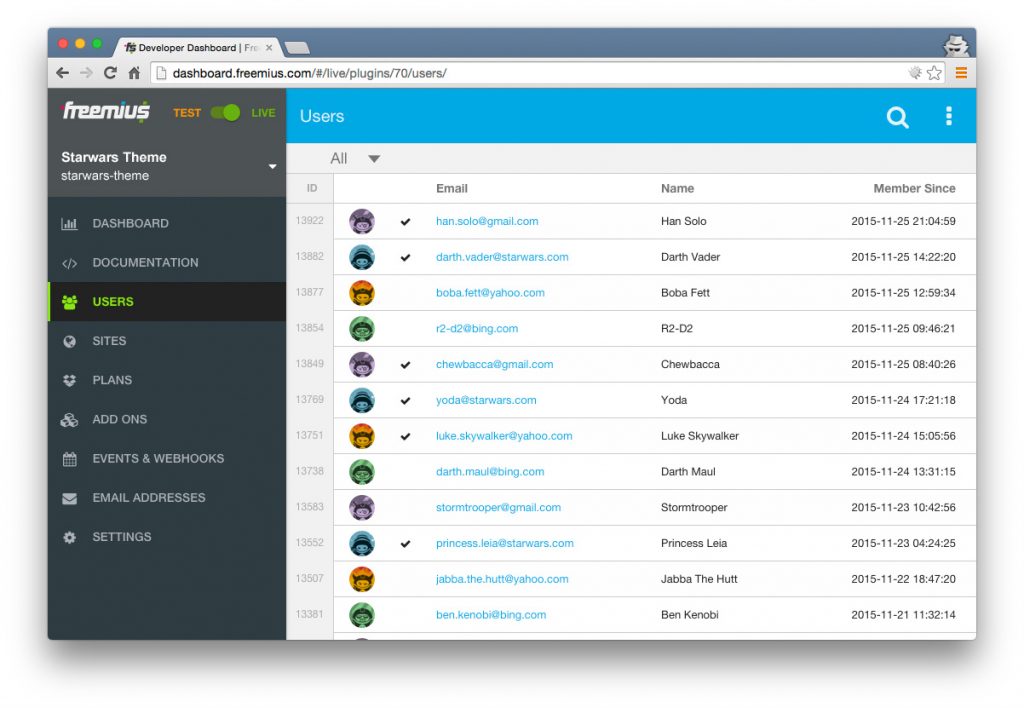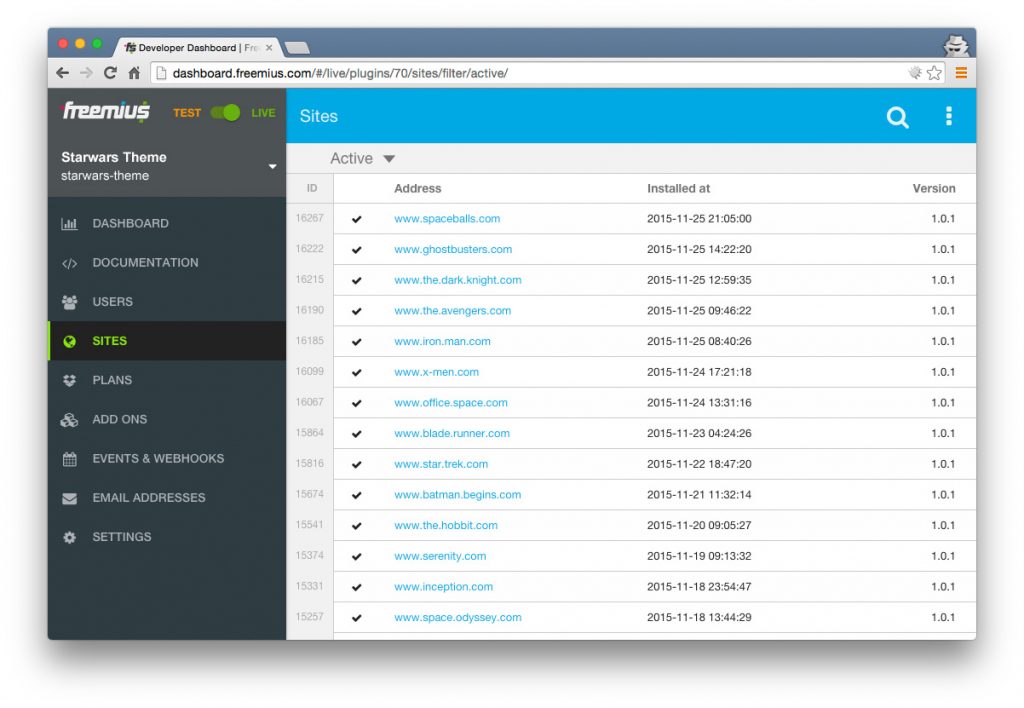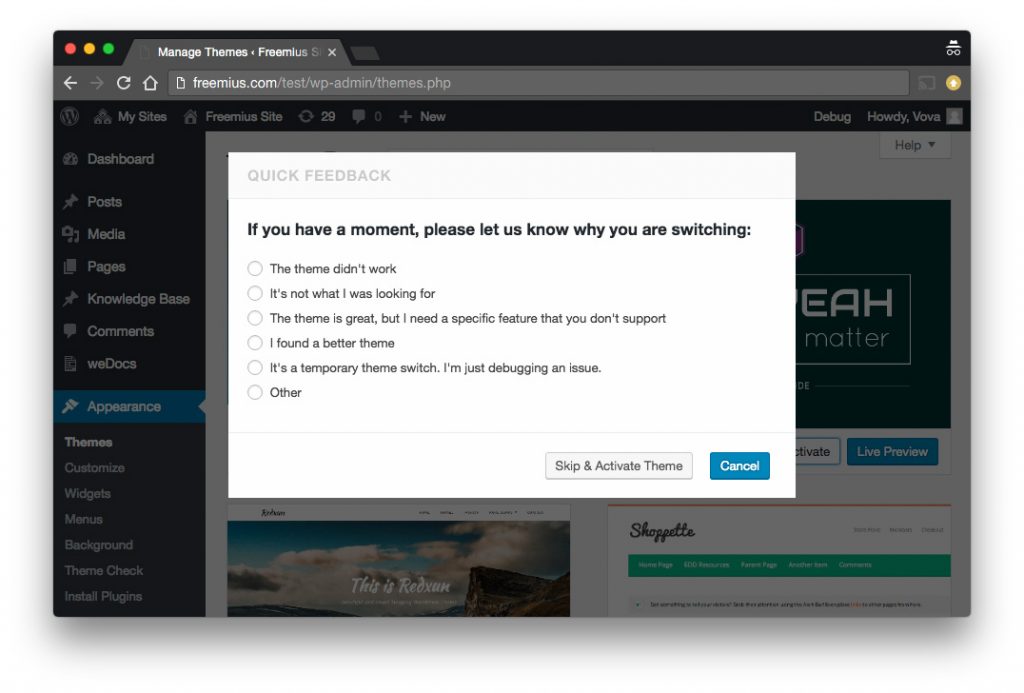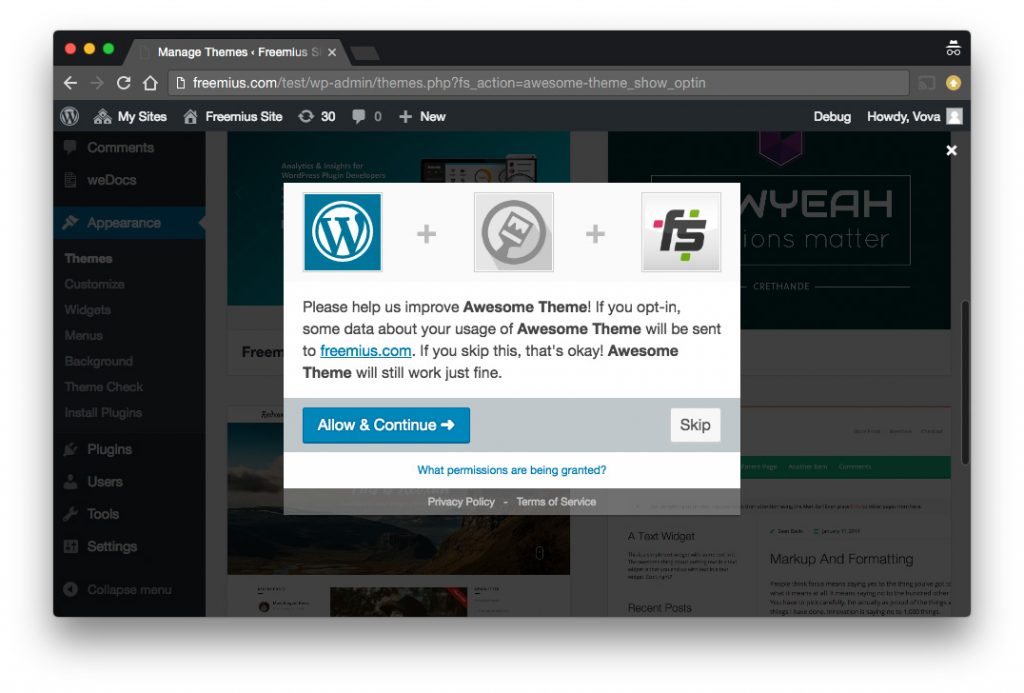A few weeks ago I had the pleasure meeting with Vova Feldman, the co-founder & CEO at Freemius. We had a great conversation over coffee learning about each other's visions and brainstorming ideas on how we can mutually help to the WordPress business community, specifically helping the themes & plugins market to grow and thrive (we are both heavily invested in that market).

We found a lot of similarities in our views on the WP space, and I wanted to give Vova the stage to share Freemius with the WPML's partners community because I believe it can help you build better & more successful commercial products, and that's beneficial for the WordPress ecosystem as a whole.
I'll let Vova take it from here.
Thank you so much Amir for giving me this opportunity.
After my conversation with Amir, I learned that WPML partners are mainly medium to large theme businesses, mostly based on ThemeForest, so in this coverage, I'll focus on how Freemius can help you. If you are a plugin developer, or a theme developer that sell from your own shop, this review is still relevant for you (just replace the word theme with a plugin).
Data is the King
Most of you rely on the marketplace and WordPress.org provided data. This data is great and can provide insights on your sells. But where is your theme is used and how, not so much 🙂
Here’s a set of trivial questions that every SaaS company product manager knows, can you answer those questions?
- What is the lifecycle of your purchase theme? Or how long a website will be using your theme on average?
- What are the main reasons driving people to switch from your theme to another?
- What are the best features of your theme?
- What are the missing features that could increase the usage of your theme?
- What is your abandon rate?
- How many sites are still running PHP 5.2 with your themes? (should you continue supporting it?)
- Is your theme used by large companies / enterprises? (if you could add a logo of Microsoft to your landing page that will sure increase your brand’s trust)
- What is the exact moment a customer switched to another theme?
- What are the most common plugins your theme is usually installed with?
If you have the answers to those questions – shapo! You are a rare kind of data-driven theme business. Unfortunately, most plugin and theme developers in the WordPress ecosystem don’t have a clue about those things.
You might ask yourself why the heck should you care? The answer to that is plain simple – you can make more money!
Did I get your attention now? 😉
Here are a few ways how you can leverage data to increase your bottom line.
Building Better Themes – The “Feedback Loop”
One of the fundamentals of product development is a concept called the “Feedback Loop”. Product development is an ongoing process where you come with assumptions (“I think that the cars industry could be a great niche for themes”), you test them by implementing those assumptions into your product, measure the success using data, and then you take what you’ve learned and either keep the “feature”, throw it into the garbage or improve it. And the cycle goes on.
The data measuring is the missing part in WordPress products ecosystem today. Which means that if you are not tracking data points you are simply “flying blind”. The only feedback you can rely on are pissed customers that ask for support. Or super happy customers that love your product and left a great review (those are usually great for the ego, but not so much for improving the product).
Without the data there’s no loop which means that you develop a theme, cross your fingers and hope for the best.
Data can help you to improve your themes, find your weakest links like missing features, understand why your customers switch to different themes and why, reduce the abandon rate, and perfect it based on hard data (not a bias customer’s feedback).
Better Marketing
Knowing your customers and where your themes are being used is a huge asset. Besides having some popular logos on your landing page, it will help you understanding who is your typical customer and what are the common use-cases your theme is used for. This is invaluable data that will help you to perfect your marketing, paid ads, affiliation… Or, maybe realize that your current marketing strategy was totally wrong.
Better Pricing
What if you find out that a significant percentage of your customers are mid-large businesses with over 100 employees? Are you still going to charge $100 for a theme? Obviously, it’s up to you. But, you could also probably double or triple your prices without seeing a decrease in your customer base.
Indeed, that’s an extreme example. But here’s more common use-case. If you find that many of your customers are freelancers and agencies that build many websites every year. An “all you can eat” membership plan where you offer all your themes for a monthly subscription could be a compelling offering and a great bump to your recurring payments.
Affiliation
If you knew what’s the most common premium plugin that your customers use together with your theme you could become an affiliate of that plugin to making some extra cash by promoting this plugin to users who install your theme or maybe even partnering with the plugin vendor for cross-promotion.
Marketing Automation
Knowing the exact moment when a customer switches from your theme to another is crucial. Yes, it might be too late, but it also can give you a chance to win that customer back, or at least try understanding what’s the reason for the switch so you can improve (remember the “Feedback Loop”?).
There are two main reasons you want to win those customers back:
- They are potential buyers for further themes. If you can show them that you care by reaching out, you increase their trust in your brand which increases the chances buying more themes from your company.
- Recurring revenues! Yes, if you sell on a marketplace like ThemeForest, recurring payments aren’t part of the deal. But if you start selling on your own (which I’ll cover in the next part of this post), you can continue making money for as long as the customer is using your themes.
Upselling from Freemium Themes
If you have a free (or a freemium) theme on WordPress.org it feels great when you see the active installs counter jump to 1,000 installs, 10,000 installs – amazing right!
What is that really means? How’s that feel to have thousands of “ghost” users without really having them? I bet it’s frustrating. As the number goes up, it means that you know less and less of your users.
The whole concept of the freemium model is based on the ability to provide enough value in the free version for lead generation and then using marketing techniques to try and get them on-board to the paid plan. Yes, you can add some marketing material in the theme WP Admin setting page and maybe one lousy link in the customizer, but the fact that you don’t know who are your users and that there’s no proper way to communicate with them is the antithesis of the freemium business model.
The one big misconception is that you, a theme or plugin developer, are not allowed to track any data on WordPress.org (or marketplaces like ThemeForest). But that’s actually not the case. If you read the fine prints, you can do so as long as you get the explicit permission from the user with an opt-in mechanism.
Having a direct communication channel with your users will enable you to interact with them for a bunch of reasons like different announcements, release notes, security updates, and marketing the paid theme. It will help you to really “have” your users and not just being a counter.
Tip: Please don’t be a spammer. Obviously, your emails system should have an unsubscribe link. But also try to build your email campaign to provide real value for the users. You first need to give before you make the ask. If you send an upsell email to your premium theme version a minute after the user installed your free theme it will only do the opposite effect on your brand and will make you look bad. So be responsible!
How Can Freemius Help You Becoming A Data King?
Short answer: Freemius Insights does all of that – automatically – for you 🙂
Longer answer: Freemius comes with an out of the box opt-in mechanism that captures the user and site information (like site language, WP version, PHP version, country), and does event based usage-tracking to capture events like theme version updates, changes in the site’s stack (e.g. PHP version, WordPress version), theme switch and more.
In just a few minutes of adding the SDK to your theme, you’ll start seeing a picture of who are the users that are using it and where (the sites that your theme is installed on).


Adding to that, the Freemius powerful webhooks mechanism, you’ll be able to add custom webhooks for marketing automation to do things like adding the customer to your MailChimp mailing list upon installation, emailing a customer who just uninstalled your theme to try and win him back, segmenting your customers based on their origin country using segment.io, or push them to intercom.io for a drip campaign.

Event based tracking is great but even if in theory we could track every interaction in the customer’s site, it’s really hard to pinpoint the reason why a customer decides to switch for another theme. Inspired by MailChimps after unsubscribe form, we managed to solve that problem (without tracking every interaction) by simply triggering a feedback form upon a theme switch, asking the user what’s the reason for the switch:

You’ll be surprised but 82% of the users that are exposed to that form are happy to provide that feedback. And that’s gold!
Now that you became a data-driven theme author, it’s time to talk shop!
Selling from Your Own eStore
There are plenty of reasons why you’d want to start selling your premium WordPress themes outside the marketplace, here are the most common:
Growth Cap
ThemeForest is a wonderful way to get started, but for most authors, it's very hard to grow beyond some point due to the aggressive competition in the marketplace and the huge inventory.
High Commission
Also, if you grow big and become an Elite Author you still have to face the 32.5% commission rate (before taxes), and that could be harsh when you are grossing tens or even hundred of thousands of dollars every month. Especially if you already established your brand and people are searching especially for your themes.
Unscalable Business Model
Moreover, ThemeForest one-time payment and lifetime updates support is an outdated business model and already proven to be an inadequate and unsustainable model.
Transitioning from ThemeForest into Selling Themes from Your Own Website
Start Collecting Your Customer Emails
Due to the Australian privacy regulations, Envato is forbidden to disclose the buyers' list with their ThemeForest authors. Other theme marketplaces don't share that too. This practice means that even if you have thousands of customers, there's no way for you to reach them out for marketing/announcements/releases/upsell reasons, or other types of communication.
Instead of pointing fingers, you can take a protective approach. Premium theme authors are allowed to collect the information about their customers from within the theme, with the customer's consent. It's compliant with the WordPress.org guidelines and I personally confirmed with the Envato team that they permit that as long as there's a proper opt-in mechanism.
You can develop the opt-in mechanism yourself and send the data to your servers, or you can easily leverage Freemius for that with a simple 5-min integration.

The benefit of choosing Freemius besides the technical part is that we strictly follow all the guidelines, have the know-how to get the best opt-in conversation rates (~60%), and we provide advanced visualization tools so you can take actions with the data.
Sell WordPress Themes Directly from Your Website
Once you established your brand and generate enough monthly traffic to your site, you can leverage that traffic and your buyers' mailing list that you've built using Freemius to start selling new premium themes. If you choose to sell with Freemius Checkout, you can do that practically in minutes, and you can sell from any website, with a built-in secure PCI compliant checkout, Software Licensing, Automatic Updates, and Recurring Revenues (with automatic renewals). All while you keep the vast majority of the revenues in your pocket, and without the need to even register for a Stripe account which is currently only working with a range of limited countries, or a PayPal account, that doesn't available in countries like Pakistan or Bangladesh.
If you are an EU customer, another huge benefit of selling your premium WordPress themes with Freemius is that we act as a reseller, which means that we take care of all the EU VAT hassle for you, and you can simply handle all your taxes with a single invoice a month (that will significantly reduce your accounting costs, potentially you won't even need to hire an accountant).
You can see Freemius Checkout in action on DaisyThemes.com (try to buy the theme):
https://daisythemes.com/theme/wellness/
Strategy Recap / TODOs
- Add an opt-in mechanism to your free and premium themes.
- Capture usage data and iterate your product making it better and better.
- Start building a mailing list of your customers.
- After your brand is established, leverage your organic traffic, users & customers mailing list, and marketing efforts, to sell new products (plugins or themes) directly from your own site while keeping most of the revenues to yourself.
- Be happy and contribute back to the community so we can all grow together.
Closing Notes
OnTheGoSystems, the company behind WPML, is not affiliated with Freemius. We know some of Freemius team and they're great folks. Their product is very impressive and looks useful for WordPress businesses who use a combination of free and paid products. We work with many other authors and we wanted to share this information, in the hope that it will help our partners and colleagues.
Any questions, suggestions and ideas are very welcome.
